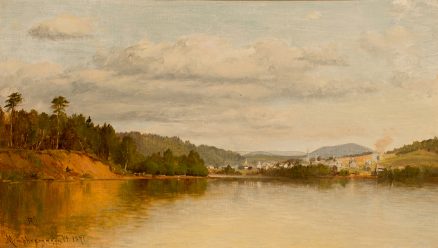- Categories
- Landscapes
- Zoom in on Artwork
- Print Page
- Email Page to Friend
Junius Sloan’s small landscape painting depicts the southern end of Lake Memphremagog near the border between Vermont and Canada, with the town of Newport spread along the distant shore under an overcast sky. The purely natural scene on the left, where trees crown a ridge above the undeveloped shore, contrasts with the vista of settlement on the right; there, clusters of houses, church spires, and a factory emitting a plume of smoke suggest a variety of human activities. The emphatically horizontal scene is dominated by the stretch of calm lake water, which spreads the full width of the composition. Although this suggests that Sloan viewed the scene from a boat on the water, the artist more likely positioned himself on the peninsula to the north of the town that shelters it from the broader body of the lake. In the painting’s flat, open composition, foreground expanse of water, and attention to transient effects of light and atmosphere, Sloan demonstrated his awareness of a recent trend in American landscape painting in favor of wide vistas of undramatic flat coastal scenery.
Sloan painted this canvas on one of the nearly annual tours of the Northeast that provided landscape subjects for much of his career. As a twenty-one-year-old self-taught itinerant portrait painter Sloan had made his first excursion to Vermont in 1848 primarily to see firsthand the mountainous terrain that, as a native of northern Ohio, he knew only from pictures and written descriptions. Later, he left Chicago after his initial stay in the city partly in order to be nearer to the settings on which he had founded his modest reputation as a landscape painter. In 1871, when he executed this work, Sloan was living amidst the celebrated scenery of the Hudson River Valley, in Hyde Park, New York, some ninety miles north of New York City. That summer, he painted intensively in Vermont’s Connecticut River Valley and Lake Champlain regions, as well as around Lake Memphremagog in the far north. There, the town of Newport was prospering in the wake of the Civil War. Two years after the railroad arrived in 1863, lumber processing, which powered the town’s economy for the next century, began with the opening of the first mill—possibly indicated in Sloan’s image by the smoke-belching structure on the right. On the opposite shore the artist pictured a raw, eroded bank that hints at the industry’s degradation of the old-growth forests of the Northeast.
In his full-size canvases Sloan painted the more dramatic natural beauty of the Lake Champlain and Lake George regions much as a tourist might wish to remember them, with massive mountains in the hazy distance under serene, delicately tinted pastel skies that evoke beneficent nature and a sense of repose. His more naturalistic Lake Memphremagog, Vermont, in contrast, presents a less spectacular setting and is devoid of conspicuous sentiment. While the composition is carefully balanced, the painting’s relatively loose brushwork, portable scale, and fresh realism suggest that Sloan painted it on the spot, in the manner of a sketch; indeed, his detailed inscription at the lower left localizes the creation of this work in time and place. This too demonstrates the artist’s awareness of contemporary developments in American landscape painting: by the Civil War era, study-like works were beginning to be exhibited and appreciated as fine art objects in their own right. Previously seen only as a means to an end—the full-size, highly finished painting—these works were increasingly valued as more direct, authentic, and intimate records of the artist’s experience of his subject and his process of capturing it. In Sloan’s Lake Memphremagog, Vermont, the effect of spontaneity and unedited naturalism disguises a carefully framed and composed view.
Wendy Greenhouse, PhD
Donated by M. Christine Schwartz to The Richard H. Driehaus Museum, Chicago, Illinois, in 2023
